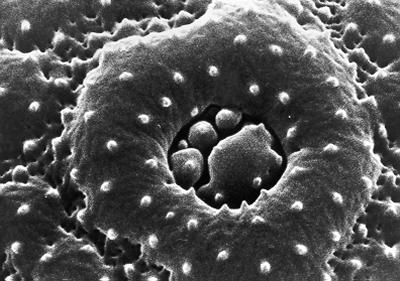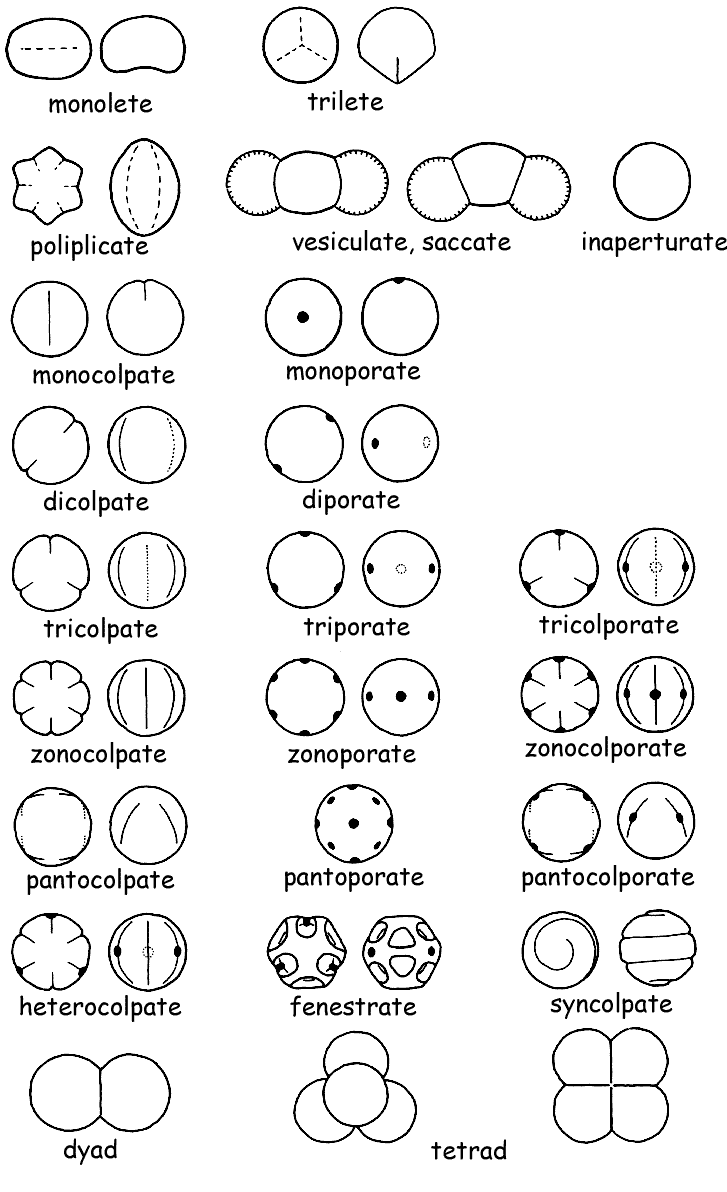






TYPES OF APERTURES IN MICROSPORES
The first characteristic to be considered when identifying pollen grains are the apertures. An aperture is a thin or missing part of the exine, which is independent of the patterning of the exine.

REM-photograph: porus with clear annulus and operculum (lid), Plantago lanceolata by Lucia Wick, IPS
The first characteristic to be considered when identifying pollen grains are the apertures. An aperture is a thin or missing part of the exine, which is independent of the patterning of the exine.
Two different types of apertures can be distinguished: pores and fissures (colpi). The latter are more primitive, they are elongated with pointed ends. Pores are usually isodiametric. They can also be slightly elongated but, in contrast to colpi, they have rounded ends. In some pollen grains, the exine around the apertures is either thicker or thinner. In pores this border is termed annulus (typical in grass pollen) and in colpi margo (e.g. in Hedera helix). Pollen grains with pores are porate and those with colpi are colpate. If both pore and colpus are combined in the same aperture, the pollen grain is colporate.
Microspores can be divided into groups according to the number, position and type of apertures. This classification is simple and consistent. The number of apertures is indicated by the prefixes mono-, di-, tri- tetra-, penta-, hexa- and poly- with the above terms porate, colpate oder colporate. Usually three pores and/or colpi are present that are regularly spaced around either the edge or the equator of the pollen grain, depending on whether the pollen grain is seen from the polar or equatorial view. If more than three apertures are present, they can either be regularly spaced around the edge, or equator respectively, (zonoporate/zonocolpate), or over the entire surface (pantoporate/ pantocolpate).
Spectrum of possible pollen types

In: G. Lang, 1994, p. 45
The
figure above shows the entire spectrum of possible pollen types. Some,
however, do not fit into the classification system as defined so far. The
so-called syncolpate pollen grains have two or more colpi that are fused
at the ends. These colpi can sometimes form a spiral. Fenestrate pollen
grains form a further group. They have large window-like spaces, where the
tectum is missing. (see chapter 2.3), the Asteraceae (Cichorioideae),
among others, belong to this group. Inaperturate pollen are rare
microspores without apertures (Juniperus). The Cyperaceae, for
example, have more or less round apertures in the ectexine, but, unlike
pores, these do not have a clear margin and are termed lacunae (sing.
lacuna). In some pollen grains, e.g. birch and alder, the two layers of
the exine are separated around the pores and form a chamber between the
inner and outer exine (vestibulum). Finally there are the so-called
bisaccate (pollen grains with "air-bags", e.g. the conifers
spruce, pine, Pinus cembra and fir.
The cell-wall structure of fern- and moss-spores differs from that of
pollen grains and the spores do not have pores or colpi. They merely have
a fissure in the sexine (see chapter Morphology).
Monolete spores only have a single fissure, trilete spores have three
fissures that form a 'Y' ("Mercedes star").